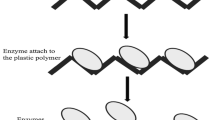Abstract
Snails from a contaminated urban car park were fed an experimental diet for 64 days. One group received a high Pb diet for the duration, and another group were removed from the high Pb diet after two days. Shells were analyzed at various intervals to measure Pb uptake and loss. Regression analysis of twenty-eight shells for each treatment suggests that the weight of Pb in the shell increased linearly with time, but loss from the shell was correlated with soft tissue Pb levels. The shells of fourteen snails from an uncontaminated site accumulated Pb less quickly on the high Pb diet, and had lower Mg and Ca concentrations. All snails lost Mg from the shell following the initial dose, possibly as part of a detoxification mechanism for heavy metals. The shell may lose Pb over a number of days, serving as a short-term sink for Pb which it releases when soft tissue concentrations fall.
Similar content being viewed by others
References
Beeby AN (1985) The role ofHelix aspersa as a major herbivore in the transfer of lead through a polluted ecosystem. J Appl Ecol 22:267–275
Beeby AN, Eaves SL (1983) Short-term changes in Ca, Pb, Zn and Cd concentrations of the garden snailHelix aspersa Muller from a central London car park. Environ Pollut (A) 30:233–244
Beeby AN, Richmond L (1987) Adaptation by an urban population of the snailHelix aspersa to a diet contaminated with lead. Environ Pollut 46:73–82
— (1988) Calcium metabolism in two populations ofHelix aspersa on a high lead diet. Arch Environ Contam Toxicol 17:507–511
Bias R, Karbe L (1985) Bioaccumulation and partitioning of cadmium within the freshwater musselDreissena polymorpha Pallas. Int Rev Ges Hydrobiol 70:113–125
Burton RF (1972) The storage of calcium and magnesium phosphates and of calcite in the digestive glands of the Pulmonata (Gastropoda). Comp Biochem Physiol 43A:655–663
Coughtrey PJ, Martin MH (1976) A comment on the analysis of biological material for lead using atomic absorption spectroscopy. Chemosphere 5(3):183–186
De Jorge FB, Haeser PE (1968) Further biochemical studies on the snailStrophocheilus oblongus musculus Becquaert, 1948. Comp Biochem Physiol 26:627–637
Edwards AL (1985) Multiple Regression and the Analysis of Variance and Covariance (2nd Edn). WH Freeman, New York
Everard M, Denny P (1984) The transfer of lead by freshwater snails in Ullswater, Cumbria. Environ Pollut (A), 35:299–314
Gordon MS, Bartholomew GA, Grinnell AD, Jorgensen CB, White FN (1982) Animal Physiology (4th Edn) Macmillan, New York
Hammond PB (1972) (Editor) Lead: Airborne lead in perspective. National Academy of Sciences, Washington DC
Harrison RM, Laxen DPH (1981) Lead Pollution: Causes and Control. Chapman Hall, London
Howard B, Mitchell PCH, Ritchie A, Simkiss K, Taylor M (1981) The composition of intracellular granules from the metal-accumulating cells of the common garden snail (Helix aspersa) Biochem J 194:507–511
Ireland MP (1986a) Effects of wound healing on zinc distribution and alkaline phosphatase activity ofHelix aspersa (Gastropoda:Pulmonata). J Mollusc Stud 52:169–172
— (1986b) Studies on the effects of dietary beryllium at two different calcium concentrations inAchatina fulica (Pulmonata). Comp Biochem Physiol 83C, (2):435–438
Mouw DR, Wagner JE, Kalitis K, Vander AJ, Mayor GH (1978) The effect of parathyroid hormone on the renal accumulation of lead. Environ Res 15:20–27
Quaterman J, Morrison JN, Humphries WR (1978) The influence of high dietary calcium and phosphate on lead uptake and release. Environ Res 17:60–67
Russell LK, De Haven JI, Botts RP (1981) Toxic effects of cadmium on the garden snail (Helix aspersa). Bull Environ Contam Toxicol 26:634–640
Simkiss K, Mason AZ (1984) Cellular responses of Molluscan tissues to environmental metals. Mar Environ Res 14:103–118
Sokal RR, Rohlf FJ (1981) Biometry (2nd Edn) WH Freeman, San Francisco
Stromgren T (1982) Effects of heavy metals (Zn, Hg, Cu, Cd, Pb, Ni) on the length growth ofMytilus edulis. Mar Biol 72:69–72
Sunila I, Lindstrom R (1985) Survival, growth and shell deformities of copper- and cadmium-exposed mussels (Mytilus edulis L.) in brackish water. Estuar Coast Shelf Sci 25:555–565
Watson CA (1971) Ammonium pyrrolidine dithiocarbamate (APDC): Reagent for various metals. Monograph No. 74, Hopkin and Williams, Essex, UK
Wilbur KM (1964) Shell formation and regeneration. In Wilbur KM and Yonge CM (eds) Physiology of the Molluscs. Vol. 1. Academic Press, New York
Author information
Authors and Affiliations
Rights and permissions
About this article
Cite this article
Beeby, A., Richmond, L. The shell as a site of lead deposition inHelix aspersa . Arch. Environ. Contam. Toxicol. 18, 623–628 (1989). https://doi.org/10.1007/BF01055031
Received:
Revised:
Issue Date:
DOI: https://doi.org/10.1007/BF01055031




